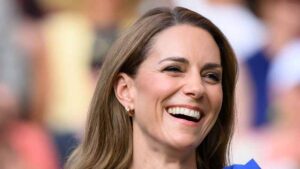
Image (GETTY)
Kate Middleton and Prince Harry’s rift appears far from resolution, as revealed by royal author Emily Andrews. The estrangement, stemming from Harry’s public remarks about Kate on television and in his memoir, has deepened over time.
In an article for Closer, Andrews sheds light on the bridges Harry has burnt and the subsequent impact on his relationship with Kate. Andrews writes, “What has kept her going are her family and friends rallying around. Sadly, the same can’t be said for her brother-in-law, who she was once close to. Now she’s faced with her darkest days, where has Harry been?”
The once-close bond between Kate and Harry has been significantly strained since his relocation to the United States and his high-profile engagements. Harry’s new life, characterized by public appearances and a scathing memoir, has created an environment where reconciliation seems increasingly unlikely. Andrews continues, “With his new life in the US, high-profile TV appearances, and a scathing book to boot, it is unlikely that Harry’s shoulder will be one Kate has sought to cry on.”
Despite the growing distance, there remains a poignant argument for reconciliation. Andrews points out that illness often serves as a powerful catalyst for reunification, urging parties to set aside their differences. “But, there lies the rub. Surely illness is one of the most powerful reasons to reunite and to put the past firmly in the history books? Instead, the wedge appears to be even larger, with no sign of a bridge to connect the pair.”
The wedge between Kate and Harry seems to have only widened, with little indication of a forthcoming bridge to reconnect them. The royal family, frequently under public scrutiny, faces the challenge of navigating personal relationships against the backdrop of tradition and duty. For Kate, her support network of family and friends remains crucial, especially in the absence of the once-close bond with Harry.
As the dynamics within the royal family continue to evolve, the unresolved tension between Kate and Harry serves as a reminder of the complexities inherent in familial relationships, particularly in the public eye. The hope for reconciliation, spurred by significant life events such as illness, remains a compelling yet elusive prospect.
Emily Andrews’ insights offer a sobering perspective on the potential for mending the fractured relationship between Kate and Harry. The path to resolution appears fraught with challenges, with both parties entrenched in their new realities. Whether illness or other significant events can serve as a bridge remains uncertain, leaving the royal family to grapple with these enduring divides.


